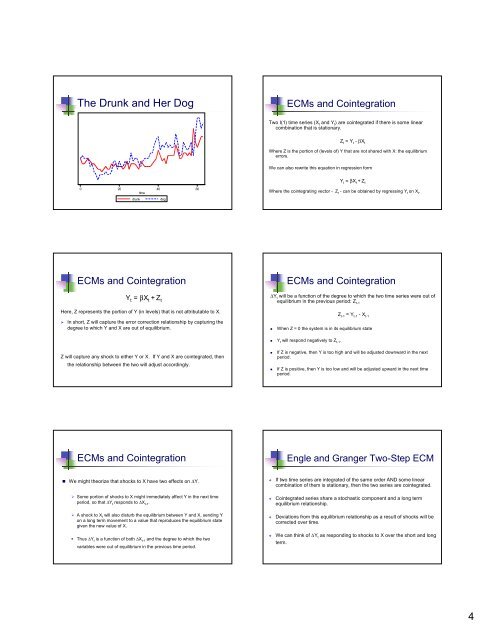An Introduction to Error Correction Models An Introduction to ECMs ...
An Introduction to Error Correction Models An Introduction to ECMs ...
An Introduction to Error Correction Models An Introduction to ECMs ...
Create successful ePaper yourself
Turn your PDF publications into a flip-book with our unique Google optimized e-Paper software.
The Drunk and Her Dog<br />
0 20 40 60<br />
time<br />
drunk dog<br />
<strong>ECMs</strong> and Cointegration<br />
Y t = βX t + Z t<br />
Here, Z represents the portion of Y (in levels) that is not attributable <strong>to</strong> X.<br />
� In short, Z will capture the error correction relationship by capturing the<br />
degree <strong>to</strong> which Y and X are out of equilibrium.<br />
Z will capture any shock <strong>to</strong> either Y or X. If Y and X are cointegrated, then<br />
the relationship between the two will adjust accordingly.<br />
<strong>ECMs</strong> and Cointegration<br />
� We might theorize that shocks <strong>to</strong> X have two effects on ΔY.<br />
� Some portion of shocks <strong>to</strong> X might immediately affect Y in the next time<br />
period, so that ΔY t responds <strong>to</strong> ΔX t-1 .<br />
� A shock <strong>to</strong> X t will also disturb the equilibrium between Y and X, sending Y<br />
on a long term movement <strong>to</strong> a value that reproduces the equilibrium state<br />
given the new value of X.<br />
� Thus ΔY t is a function of both ΔX t-1 and the degree <strong>to</strong> which the two<br />
variables were out of equilibrium in the previous time period.<br />
<strong>ECMs</strong> and Cointegration<br />
Two I(1) time series (X t and Y t ) are cointegrated if there is some linear<br />
combination that is stationary.<br />
Z t = Y t - βX t<br />
Where Z is the portion of (levels of) Y that are not shared with X: the equilibrium<br />
errors.<br />
We can also rewrite this equation in regression form<br />
Y t = βX t + Z t<br />
Where the cointegrating vec<strong>to</strong>r - Z t - can be obtained by regressing Y t on X t .<br />
<strong>ECMs</strong> and Cointegration<br />
ΔY t will be a function of the degree <strong>to</strong> which the two time series were out of<br />
equilibrium in the previous period: Z t-1<br />
Z t-1 = Y t-1 - X t-1<br />
� When Z = 0 the system is in its equilibrium state<br />
� Y t will respond negatively <strong>to</strong> Z t-1 .<br />
� If Z is negative, then Y is <strong>to</strong>o high and will be adjusted downward in the next<br />
period.<br />
� If Z is positive, then Y is <strong>to</strong>o low and will be adjusted upward in the next time<br />
period.<br />
Engle and Granger Two-Step ECM<br />
� If two time series are integrated of the same order AND some linear<br />
combination of them is stationary, then the two series are cointegrated.<br />
� Cointegrated series share a s<strong>to</strong>chastic component and a long term<br />
equilibrium relationship.<br />
� Deviations from this equilibrium relationship as a result of shocks will be<br />
corrected over time.<br />
� We can think of ∆Y t as responding <strong>to</strong> shocks <strong>to</strong> X over the short and long<br />
term.<br />
4


